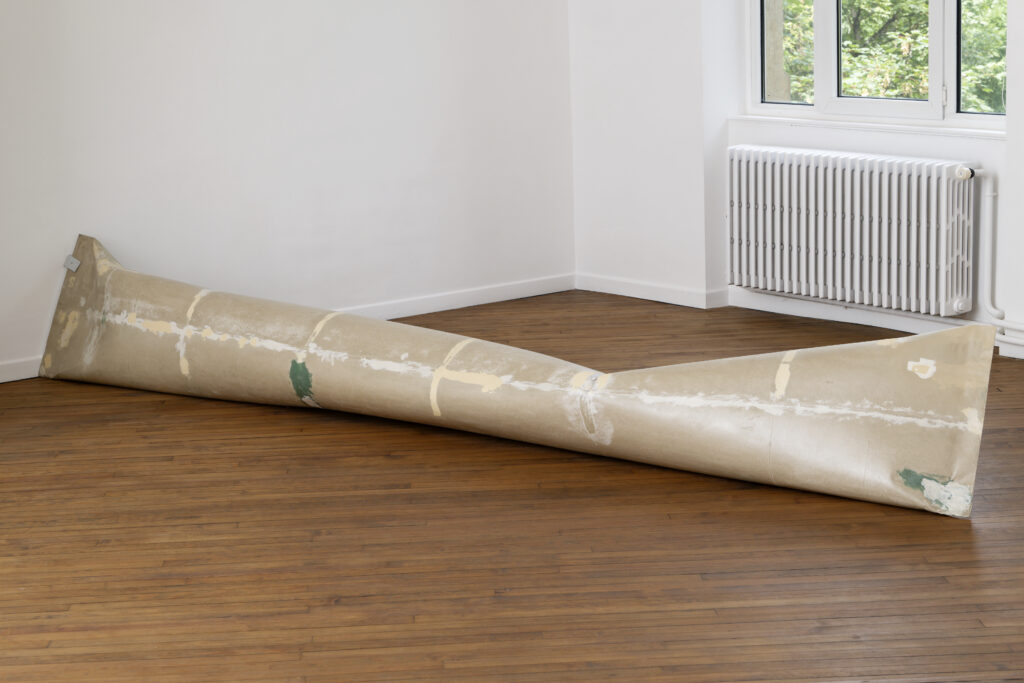Days after seeing Julia Spínola’s exhibition Même mot at the CRAC Alsace, I thought of these lines from a poem by Elizabeth Bishop:
«The art of losing isn’t hard to master;
so many things seem filled with the intent
to be lost that their loss is no disaster.» (1)
Keys, the hours that pass by without meaning and without doing anything important, the places and people we have loved. “The art of losing is easily mastered,” says Bishop, but it is through rehearsal, repetition and insistence that we acquire, you and I, the certainty that this loss is no disaster. Each loss is different but each loss also has something in common, the repetition that unites the identical with the different.
Julia Spínola’s exhibition at the CRAC Alsace embraces this strategy of repetition of the same and the different, giving rise to a multiplicity of meanings through a similarity of forms. One of the most ingenious moments of the exhibition is the installation of La Velocidad 1 (Velocity 1), a set of almost identical works in two adjacent rooms that manages to generate a very singular spatiotemporal estrangement. I have already been here but now, minutes later, I am back here again walking along a part that takes me away from where I was. Through these gestures and the repetition of certain forms and elements, as in the works Cambio de uso (Change of Use) and Totonaca, the reason for the title of the exhibition, Même mot, the same word, becomes evident.
I believe that, at first, everything starts with a linguistic gesture, of using homonymy as an element from which a journey through the work in the exhibition can be perfectly organized. In that first moment in which language took on a certain prominence and is foregrounded (closer, nearer), I thought of some statements by Julia Spínola that I read in the Lubricán catalogue, in which the artist evokes this linguistic dimension of a given moment:
«When we say that ‘something is something’ we are automatically removing ourselves from the equation, we are cheating. On the other hand, when we say ‘that rose seems red’ then we make ourselves visible in the middle, as part of the becoming of things. There is a presence that is not limited to our form but which opens, mixes and returns, describing a more circular path. Tiqqun says: we have to be aware of what happens to us when we speak. You say ‘the rose is red,’ then you go back to your things, nothing has changed, but the rose is not red, the rose seems red. (…) This also has a lot to do with the fact that I am very much in my eye, and being very much in my eye is perhaps being on the edge of language where one is already more exterior, more on the outside, where you dissolve, where you get lost.» (2)
All this happens at the very first moment, or rather, at a more distant moment. What could be mere linguistics acquires a spatial dimension when we consider that the very meaning of homonymy includes a certain distance. Homonymy, strictly speaking, occurs between two words that are written or pronounced in a similar way but whose origins and meanings are distant. In this second moment, this closer moment, I think of the ideas that Julia Spínola referred to during an intervention on the occasion of her 2023 exhibition, Persona, foto, copia (Person, Photo, Copy) at Artium Museoa, the institution in which this exhibition at CRAC Alsace was first held. Size depends on distance or proximity. A greater or lesser distance changes the size of things. Homonymy, the exercise that Julia Spínola carries out throughout her work, puts distant elements on a similar plane, forms move away and come closer, while size is created by the gesture of coming closer or moving away.
The words of Elfi Turpin, the curator and director of the CRAC Alsace, claimed that “understanding Julia Spínola’s work consists more in practicing it than in commenting on it, grasping it in the primary sense of the term, that is, grasping its body.” [3] To fully grasp Julia Spínola’s work, therefore, it is essential to actively engage with it, allowing the forms and meanings to be revealed through our direct and bodily interaction with the work, but also with the process. For this reason, the exhibition includes a publication, a sort of recipe book of workshops that the artist carried out at EINA (Barcelona), Centro Huarte (Pamplona), Artium Museoa (Vitoria-Gasteiz) and Ethall (Hospitalet), among others. These workshops, which form part of the mediation program of this exhibition, also propose a repetition, similar but different, to what they were originally.
If in Elizabeth Bishop’s poetry loss is worked on through repetition, Julia Spínola’s exhibition explores this reiteration, with similarity and difference as coexisting and complementary elements. The idea of value appears here, from the use of materials to the gesture of changing dimensions and of making objects large that would normally be smaller. Value, as we know, is a question of hierarchy, it is constituted by size and distance, and that is how Julia Spínola subverts the terms. Distance does not have to be loss. What’s more, affection always brings closer whoever (or whatever) is far away. The memory, the contact, the thought of a loved one will always create a light in infinite space that helps shelter us in the distance.
References
(1) “One Art” de Elizabeth Bishop in Poetry Foundation: https://www.poetryfoundation.org/poems/47536/one-art
(2) Julia Spínola in an interview with Marc Navarro, Sombra caracol. Una Conversación en Madrid (Snail Shadow: A Conversation in Madrid), in Lubricán, Centro de Arte 2 de mayo, Móstoles, 2018, p. 69.
(3) Curatorial text of Même mot, Julia Spínola’s exhibition at the CRAC Alsace, by Elfi Turpin
Artículo publicado en A*Desk el 29/08/2024
